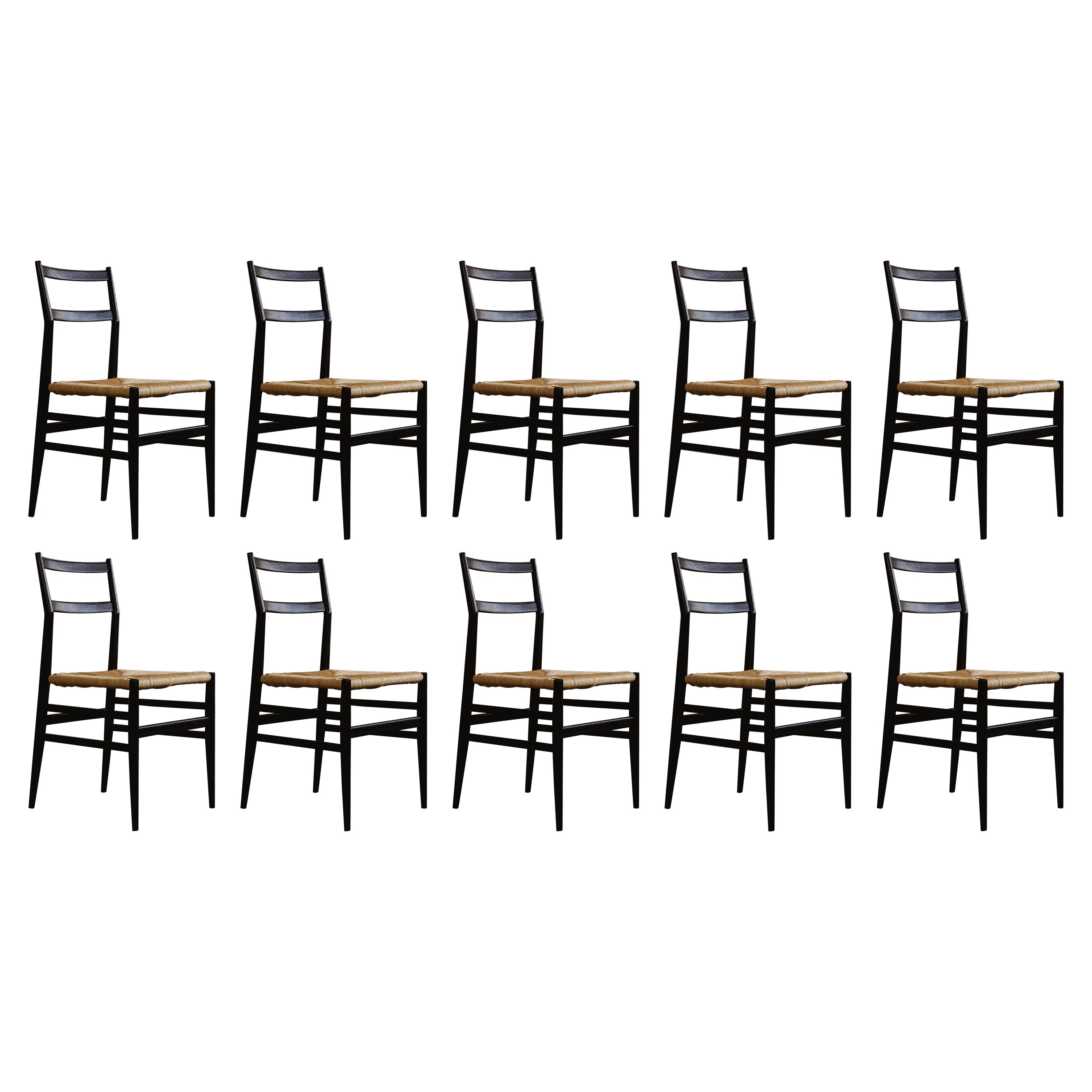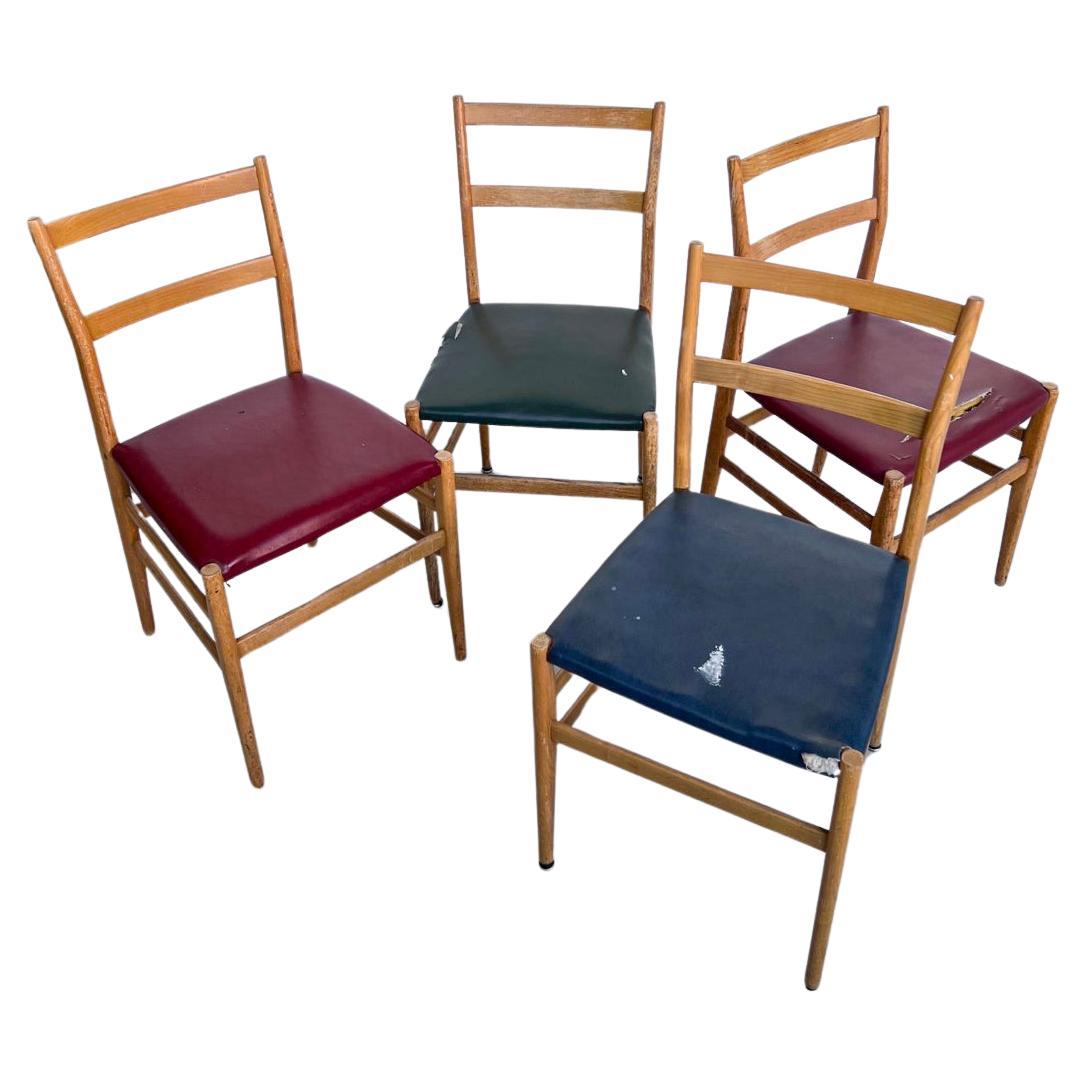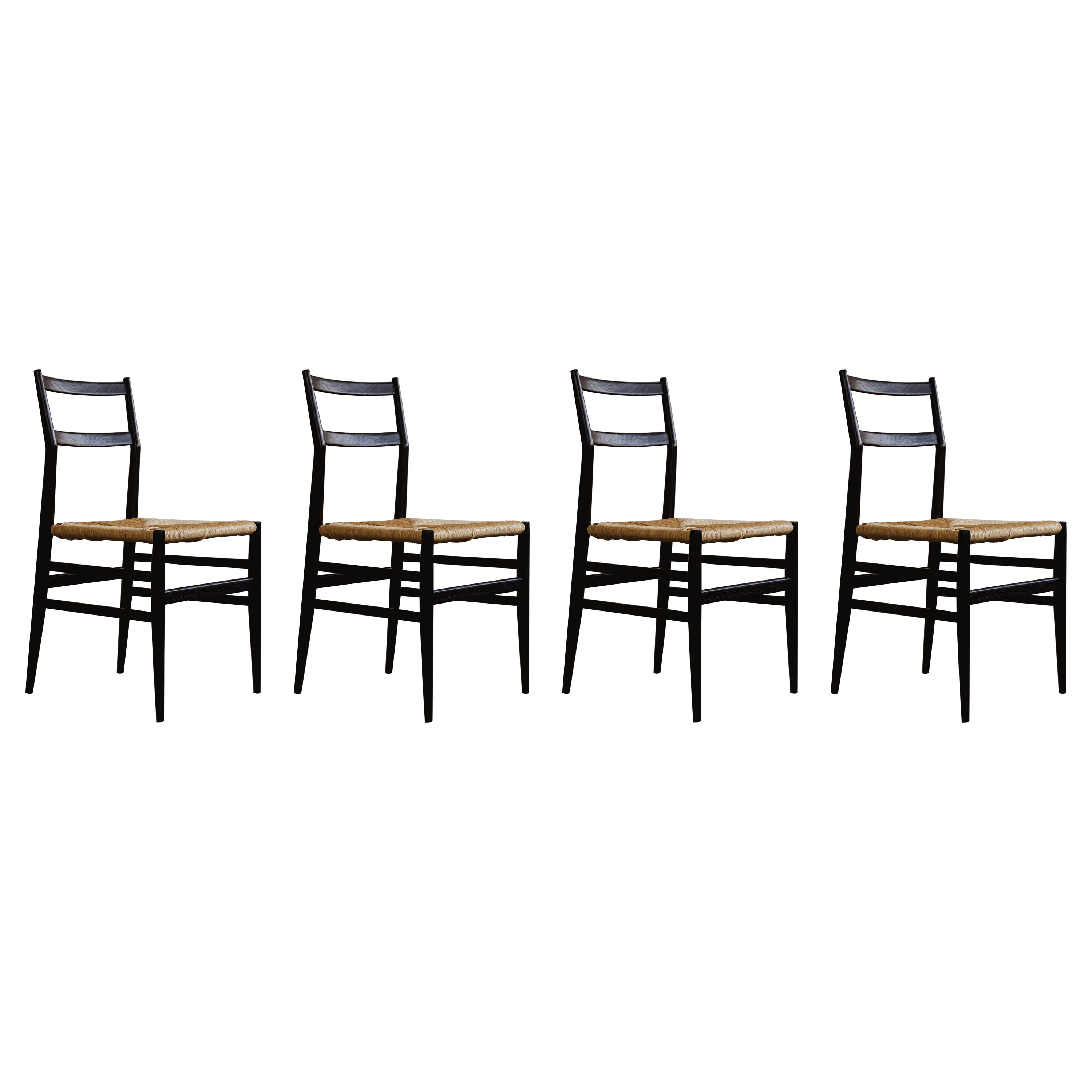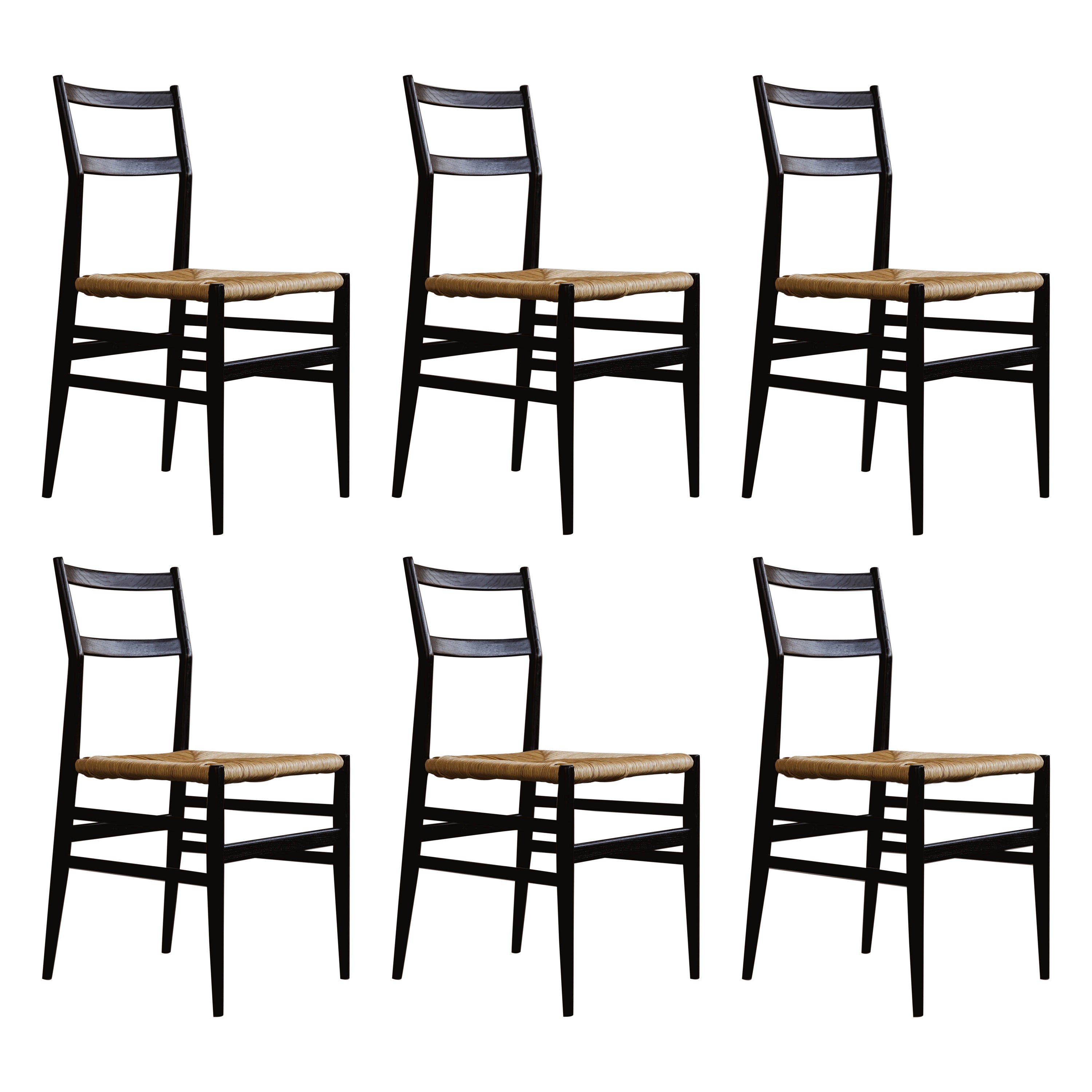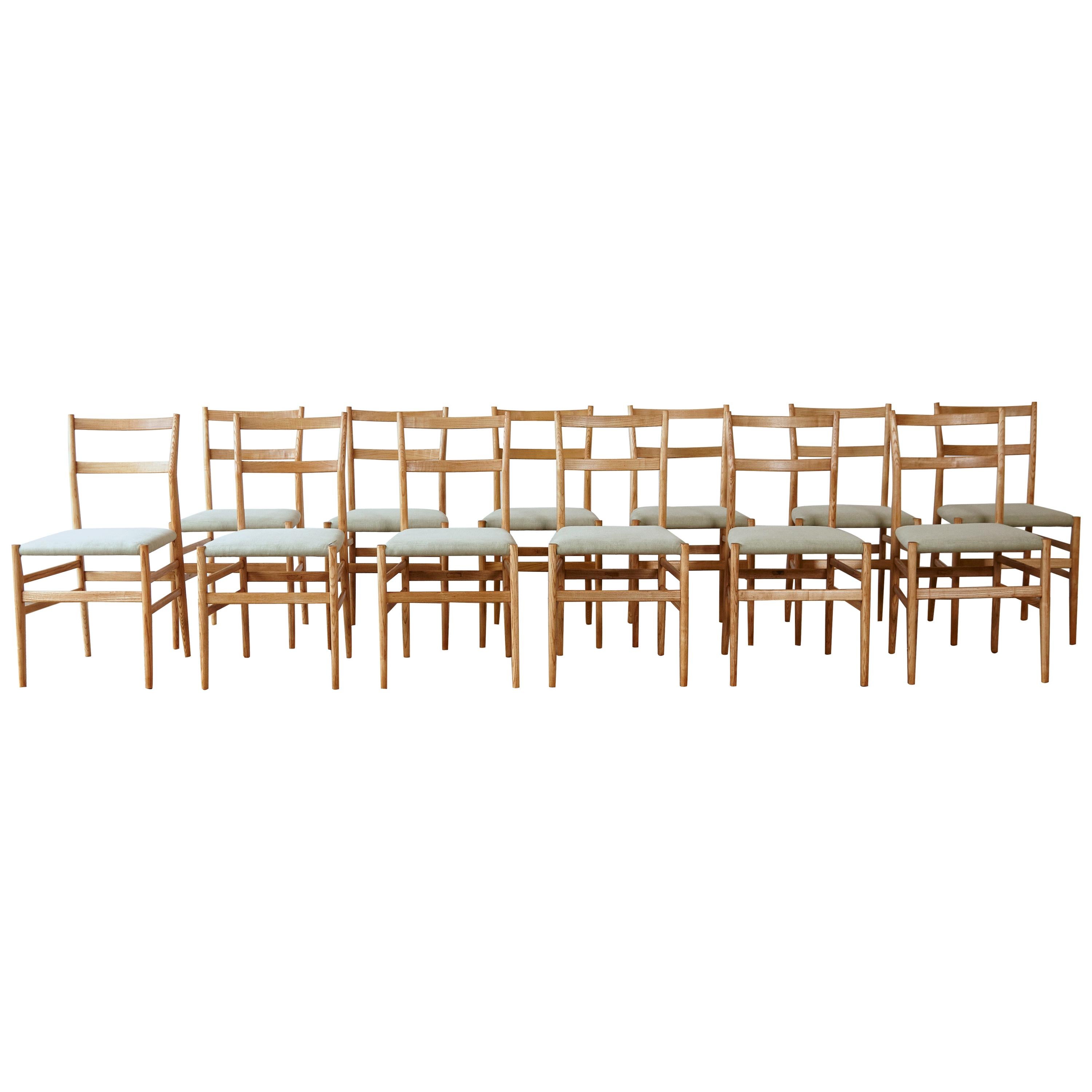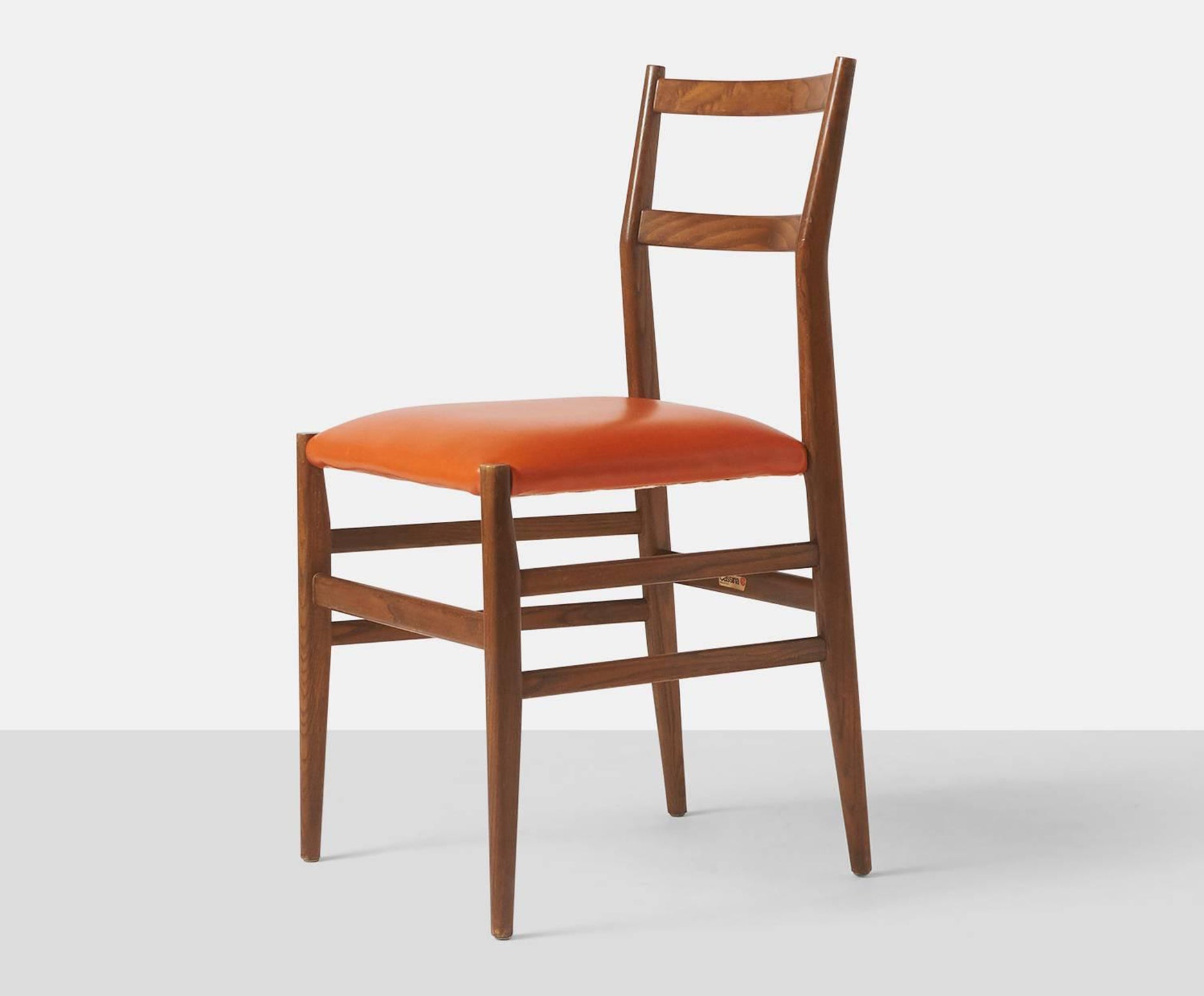Original 1950's Gio Ponti Leggera Dining Chairs by Cassina. Set of 10
About the Item
- Creator:
- Design:
- Dimensions:Height: 33.47 in (85 cm)Width: 17.72 in (45 cm)Depth: 18.51 in (47 cm)Seat Height: 18.12 in (46 cm)
- Sold As:Set of 10
- Style:Mid-Century Modern (Of the Period)
- Materials and Techniques:
- Place of Origin:
- Period:
- Date of Manufacture:1950
- Condition:Reupholstered. Refinished. Wear consistent with age and use. Minor losses. Minor structural damages. Minor fading.
- Seller Location:London, GB
- Reference Number:1stDibs: LU7049236031162
Leggera
The Leggera chair is as striking on its own as it is in any setting, which is just as Giò Ponti (1891–1979) intended.
The gifted Milanese architect — who also designed, taught and wrote — studied architecture at the esteemed Polytechnic University of Milan, graduating in 1921. A stint in an architectural office followed, as did award-winning porcelain designs for Richard Ginori. In 1928, Ponti launched the revered design journal Domus, promoting the Novocento movement, which decried the “fake antique” and “ugly modern” in architecture and design. This was very much in line with Ponti’s own distinct style, which united the historical classicism of Italy with a modern ideal. The furniture maker’s work to this day exudes that spirit of innovation and timelessness, just as it did with the Leggera chair.
Ponti brought new meaning to traditional Italian country furniture with the 1952 Leggera chair and the Superleggera that followed — specifically, he looked to the simple but well-known chairs designed in Chiavari, a nearby fishing village, for inspiration. The Leggera’s gently tapering legs, ladder back and cane seat are features that render it easily recognizable to any collector. And like most of Ponti’s furniture, its tapering supports and lightweight ashwood frame — leggera is Italian for “light” — give it a ballerina-like appearance, as if the chair is dancing on its toes. First produced by Cassina, the Leggera also represented a bold step in its reductionist construction. The frame of the chair was pared down to its most essential lines, offering the illusion of weightlessness, like Ponti’s best work.
Gio Ponti
An architect, furniture and industrial designer and editor, Gio Ponti was arguably the most influential figure in 20th-century Italian modernism.
Ponti (1891–1979) designed thousands of furnishings and products — from cabinets, lamps and chairs to ceramics and coffeemakers — and his buildings, including the brawny Pirelli Tower (1956) in his native Milan, and the castle-like Denver Art Museum (1971), were erected in 14 countries. Through Domus, the magazine he founded in 1928, Ponti brought attention to virtually every significant movement and creator in the spheres of modern art and design.
The questing intelligence Ponti brought to Domus is reflected in his work: as protean as he was prolific, Ponti’s style can’t be pegged to a specific genre. In the 1920s, as artistic director for the Tuscan porcelain maker Richard Ginori, he fused old and new; his ceramic forms were modern, but decorated with motifs from Roman antiquity. In pre-war Italy, modernist design was encouraged, and after the conflict, Ponti — along with designers such as Carlo Mollino, Franco Albini, Marco Zanuso — found a receptive audience for their novel, idiosyncratic work. Ponti’s typical furniture forms from the period, such as the wedge-shaped Distex chair, are simple, gently angular, and colorful; equally elegant and functional. In the 1960s and ’70s, Ponti’s style evolved again as he explored biomorphic shapes, and embraced the expressive, experimental designs of Ettore Sottsass Jr., Joe Colombo and others.
His signature furniture piece — the one by which he is represented in the collections of the Museum of Modern Art in New York, Germany’s Vitra Design Museum and elsewhere — is the sleek Superleggera chair, produced by Cassina starting in 1957. (The name translates as “superlightweight” — advertisements featured a model lifting it with one finger.) Ponti had a playful side, best shown in a collaboration he began in the late 1940s with the graphic artist Piero Fornasetti. Ponti furnishings were decorated with bright finishes and Fornasetti's whimsical lithographic transfer prints of things such as butterflies, birds or flowers; the Montreal Museum of Fine Arts possesses a 1950 secretary from their Architetturra series, which feature case pieces covered in images of building interiors and facades. The grandest project Ponti and Fornasetti undertook, however, lies on the floor of the Atlantic Ocean: the interiors of the luxury liner Andrea Doria, which sank in 1956.
Widely praised retrospectives at the Queens Museum of Art in 2001 and at the Design Museum London in 2002 sparked a renewed interest in Ponti among modern design aficionados. (Marco Romanelli’s monograph written for the London show, offers a fine overview of Ponti’s work.) Today, a wide array of Ponti’s designs are snapped up by savvy collectors who want to give their homes a touch of Italian panache and effortless chic.
Find a range of Gio Ponti furniture on 1stDibs.
- ShippingRetrieving quote...Ships From: Maastricht, Netherlands
- Return PolicyA return for this item may be initiated within 3 days of delivery.
- 1950s Brazilian Design Extending Dining Table by Celina DecoraçõesBy Celina DecoracoesLocated in London, GB1950s Brazilian Design Extending Dining Table by Celina Decorações Fold our extension leaf contained within the structure of the table, underneath the table top, which adds 50 cm, making the table 249 cm long. Celina Decorações Rio de Janeiro and São Paulo CELINA ZYLBERBERG...Category
Vintage 1960s Brazilian Mid-Century Modern Dining Room Tables
MaterialsHardwood
- Set of 5 1950s Art Glass Pieces by Erik Hoglund for Boda, SwedenBy Boda, Erik HöglundLocated in London, GBA Set of 5 Art Glass Pieces designed in 1950s by Erik Hoglund (1932-1998) for the iconic Swedish glass factory Boda. Measures: Rectangular pieces 11 cm wide x 9 cm deep x 3 cm high, circular pieces 7 cm diameter x 3 cm high. Erik Höglund was studied at Konstfack in Stockholm, first decorative painting with Fritz Sjöström, then sculpture with Robert Nilsson and finally graphic design 1951-1952 with Harald Sallberg. Recruited by Erik Rosén, he was an associate designer at the Boda glassworks from 1953 to 1973 and, during this period, transformed Swedish art glass production by introducing new ideas about the appearance of glass products.. While in Boda, he also worked with pine, wrought iron and furniture. Later he also collaborated with other glassworks, such as Pukeberg, Lindshammar and Studioglas Strömbergshyttan. In 1968 he founded the design company Backström & Höglund Design AB together with the glass artist Monica Backström, with the mission to design furniture, household utensils and utensils for the public environment. Höglund was also a member of Vet Hut AB, which was founded in 1971 by ten designers from the Boda glassworks, in addition to the usual work: Erik Höglund, Monica Backström, Ann Wolff...Category
Mid-20th Century Swedish Mid-Century Modern Decorative Bowls
MaterialsGlass
- 1950s Brazilian Stool by Joaquim TenreiroBy Joaquim TenreiroLocated in London, GB1950s Brazilian Stool by Joaquim Tenreiro. Two-tone wood seat on black enamelled steel base. Produced for a private commission in Copacabana, Rio de Ja...Category
Vintage 1950s Brazilian Mid-Century Modern Stools
MaterialsHardwood
- 1950s Armchair Designed by Celina Zilberberg for Celina Decorações, BrazilBy Celina DecoracoesLocated in London, GBBrazilian 1950s lounge chair. Designed by Munis Zilberberg. Manufactured by Celina Decorações. Brown velvet upholstery on solid Jacaranda base. ...Category
Mid-20th Century Brazilian Mid-Century Modern Armchairs
MaterialsVelvet, Wood
- Original David Bailey (British, b. 1938) Portrait Photograph of Roy Strong, 1971By David BaileyLocated in London, GBPhotograph executed and printed 1971, 1/1. This photograph is framed. Sir Roy Colin Strong is an English art historian and former director of the National Portrait Gallery and the V...Category
Vintage 1970s British Mid-Century Modern Photography
MaterialsPaper
- 1950s 'Orkidea' 'Orchid' Glass Vase by Timo Sarpaneva for Iittala, FinlandBy Timo Sarpaneva, IittalaLocated in London, GBA 1950s 'Orkidea' (Orchid) Glass Vase by Timo Sarpaneva for Iittala, Finland. Originally designed in 1953, the piece was initially intended as a sculpture, for which the artist wa...Category
Mid-20th Century Finnish Mid-Century Modern Vases
MaterialsGlass
- Gio Ponti 646 "Leggera" Dining Chairs for Cassina, 1952, Set of 10By Gio Ponti, CassinaLocated in Lonigo, VenetoGio Ponti 646 "Leggera" dining chairs for Cassina, black ash-wood and rope seat, Italy, 1952, set of ten. The model 646 "Leggera" is an icon of chair...Category
Vintage 1950s Italian Mid-Century Modern Dining Room Chairs
MaterialsRope, Ash
- Leggera Dining Chairs by Gio Ponti for Cassina - Set of FourBy Cassina, Gio PontiLocated in Milano, ITGiò Ponti needs no introduction: He's been arguably the most influential personality in Italian design and architecture for almost three decades, from the Fifties throughout the Seve...Category
Vintage 1960s Italian Mid-Century Modern Dining Room Chairs
MaterialsFaux Leather, Wood
- Gio Ponti Set of Four Leggera Dining Chairs by Cassina 1951 ItalyBy Gio Ponti, CassinaLocated in Montecatini Terme, ITSet of four Leggera dining chairs with structure in black lacquered wood and seat in padded blue leatherette, designed by Gio Ponti and manufactured by Cassina in 1951. Leggera is a...Category
Vintage 1950s Italian Mid-Century Modern Chairs
MaterialsFaux Leather, Wood
- Gio Ponti 646 "Leggera" Dining Chairs for Cassina, 1952, Set of 4By Gio Ponti, CassinaLocated in Lonigo, VenetoGio Ponti 646 "Leggera" dining chairs for Cassina, black ash-wood and rope seat, Italy, 1952, set of four. The model 646 "Leggera" is an icon of chai...Category
Vintage 1950s Italian Mid-Century Modern Dining Room Chairs
MaterialsRope, Ash
- Gio Ponti 646 "Leggera" Dining Chairs for Cassina, 1952, Set of 6By Gio Ponti, CassinaLocated in Lonigo, VenetoGio Ponti 646 "Leggera" dining chairs for Cassina, black ash-wood and rope seat, Italy, 1952, set of six. The model 646 "Leggera" is an icon of chair...Category
Vintage 1950s Italian Mid-Century Modern Dining Room Chairs
MaterialsRope, Ash
- Set of 12 Gio Ponti Leggera Model 646 Dining Chairs for Cassina, Italy, 1950sBy Gio Ponti, CassinaLocated in London, GBA wonderful set of twelve original, early Gio Ponti Leggera Model 646 dining chairs, Cassina, Italy, 1950s. In restored condition with new ...Category
Mid-20th Century Italian Mid-Century Modern Dining Room Chairs
MaterialsFabric, Wood
Recently Viewed
View AllRead More
Billy Cotton Layers His Interiors with Lived-In Comfort
The Brooklyn-based designer is adept at styles ranging from austere to over-the-top, espousing an architectural, detail-oriented approach also evident in his line of furniture and lighting.
The 21 Most Popular Mid-Century Modern Chairs
You know the designs, now get the stories about how they came to be.
